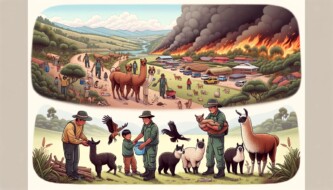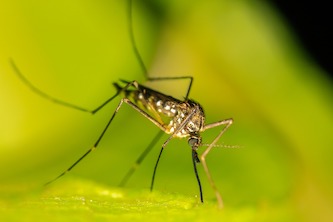Canada is currently experiencing a high number of wildfires, particularly in the western regions of the country. Severe drought conditions have contributed to the spread of these fires, leading to the evacuation of thousands of people. The town of Fort McMurray in Alberta, which was devastated by wildfires in 2016, has once again been affected, with residents being forced to evacuate. Other areas, such as Fort Nelson in British Columbia and Cranberry Portage in Manitoba, have also been impacted by fires.
The fires have been caused by a combination of factors. In some cases, high winds have knocked over trees, causing them to crash onto power lines and ignite fires. Lightning strikes have also been a common cause of wildfires. Additionally, human activity, such as careless behavior or arson, can contribute to the start of fires. Climate change and warming temperatures are also playing a role in the increasing frequency of wildfires in Canada. Dry regions, particularly in the northwest provinces, are becoming more susceptible to fires due to the warming climate.
The wildfire season in Canada has been starting earlier and earlier in recent years. Traditionally, the season began in July or August, but now it is starting as early as May. Last year, Canada experienced its worst fire season on record, with approximately 18.5 million hectares of land burned. This year, while the season has started early again, experts predict that it may not be as severe as last year. The severity of the wildfire season is dependent on weather conditions throughout the summer.
The Canadian government has warned of the possibility of another “catastrophic” wildfire season due to warmer-than-usual weather. However, it is important to note that the extent of the season will ultimately be determined by weather patterns as the summer progresses. Efforts are being made to combat and control the fires, but it may take weeks to fully extinguish them. In the meantime, air quality alerts have been issued due to the smoke from the fires, affecting both Canada and the United States.
Original news source: Why is Canada having so many wildfires this season? (BBC)
🎧 Listen:
Slow
Normal
Fast
📖 Vocabulary:
| 1 | evacuation | The process of moving people from a dangerous place to safety |
| 2 | drought | A prolonged period of abnormally low rainfall, leading to a shortage of water |
| 3 | arson | The criminal act of deliberately setting fire to property |
| 4 | susceptible | Likely to be influenced or harmed by a particular thing |
| 5 | catastrophic | Involving or causing sudden great damage or suffering |
| 6 | extinguish | To put out a fire or bring something to an end |
| 7 | frequency | The rate at which something occurs over a particular period of time |
| 8 | hectares | A unit of measurement for land, equal to 10,000 square meters |
| 9 | severe | Very intense or serious |
| 10 | impact | The effect or influence of one thing on another |
| 11 | combination | A mixture or blend of different elements |
| 12 | traditionally | In a way that is based on long-established customs or beliefs |
| 13 | ultimately | In the end, after everything has been considered |
| 14 | combat | To take action to reduce or prevent something harmful |
| 15 | alert | A warning or signal of danger |
Group or Classroom Activities
Warm-up Activities:
– News Summary
Instructions: Divide the class into pairs or small groups. Give each group a few minutes to read the article. Then, ask them to summarize the main points of the article in a few sentences. After they have completed their summaries, have each group share their summary with the class.
– Opinion Poll
Instructions: Have the students form pairs or small groups. Ask them to discuss their opinions on the following question: “Do you think climate change is the main cause of the increasing frequency of wildfires in Canada?” After they have discussed their opinions, have each group share their thoughts with the class. Then, conduct a class-wide poll by having students raise their hands to indicate whether they agree or disagree with the statement. Encourage students to explain their reasoning.
– Vocabulary Pictionary
Instructions: Write a selection of vocabulary words from the article on the board. Divide the class into teams. Each team will take turns sending one member to the front of the class. The teacher will whisper a vocabulary word to that student, who will then have to draw a picture to represent that word. The student’s team members must guess the word based on the drawing. The team with the most correct guesses wins.
– Pros and Cons
Instructions: Divide the class into two groups. Assign one group to argue the pros of early wildfire seasons in Canada, and assign the other group to argue the cons. Give the groups a few minutes to brainstorm their points. Then, have each group take turns presenting their arguments to the class. Encourage students to use persuasive language and support their arguments with evidence from the article.
– Future Predictions
Instructions: Ask the students to imagine that they are experts on climate change and wildfires. In pairs or small groups, have them discuss and make predictions about the future of wildfires in Canada. What do they think will happen in the coming years? Will the frequency and severity of wildfires continue to increase? After they have discussed their predictions, have each group share their thoughts with the class.
🤔 Comprehension Questions:
1. What regions of Canada are currently experiencing a high number of wildfires?
2. What are some factors that have contributed to the spread of these fires?
3. Which town in Alberta was affected by wildfires in 2016 and again this year?
4. How have climate change and warming temperatures played a role in the increasing frequency of wildfires in Canada?
5. When did the wildfire season traditionally begin in Canada, and when does it start now?
6. How severe was Canada’s fire season last year?
7. What factors determine the severity of the wildfire season in Canada?
8. What efforts are being made to combat and control the fires, and how long might it take to fully extinguish them?
Go to answers ⇩
🎧✍️ Listen and Fill in the Gaps:
Canada is currently experiencing a high number of wildfires, particularly in the western (1)______ of the country. Severe (2)______ conditions have contributed to the spread of these fires, leading to the evacuation of thousands of people. The town of Fort McMurray in (3)______, which was devastated by wildfires in 2016, has once again been affected, with residents being forced to evacuate. Other areas, such as Fort Nelson in British (4)______ and Cranberry Portage in Manitoba, have also been impacted by fires.
The fires have been caused by a combination of factors. In some cases, high winds have knocked over (5)______, causing them to crash onto power (6)______ and ignite fires. Lightning strikes have also been a common cause of wildfires. Additionally, human activity, such as careless behavior or arson, can contribute to the start of fires. Climate change and warming temperatures are also playing a role in the (7)______ frequency of wildfires in Canada. Dry regions, particularly in the northwest (8)______, are becoming more susceptible to fires due to the warming climate.
The wildfire season in Canada has been starting earlier and earlier in recent years. Traditionally, the season began in July or (9)______, but now it is starting as early as May. Last year, Canada (10)______ its worst fire season on record, with approximately 18.5 million hectares of land burned. This year, while the season has (11)______ early again, (12)______ predict that it may not be as severe as last year. The severity of the wildfire season is dependent on weather conditions throughout the summer.
The (13)______ government has warned of the possibility of another “catastrophic” (14)______ season due to warmer-than-usual weather. However, it is important to note that the extent of the season will ultimately be determined by weather (15)______ as the summer progresses. Efforts are being made to combat and control the fires, but it may take weeks to fully extinguish them. In the meantime, air (16)______ alerts have been issued due to the smoke from the fires, affecting both Canada and the United States.
Go to answers ⇩
💬 Discussion Questions:
Students can ask a partner these questions, or discuss them as a group.
1. What is your opinion on the increasing frequency of wildfires in Canada?
2. How would you feel if you had to evacuate your home due to a wildfire?
3. Do you think climate change is the main cause of the increasing severity of wildfire seasons in Canada? Why or why not?
4. What measures do you think the Canadian government should take to prevent wildfires?
5. Have you ever experienced a wildfire or natural disaster? If so, how did it impact you?
6. Do you think the media accurately portrays the severity of wildfires in Canada? Why or why not?
7. What steps can individuals take to reduce the risk of wildfires in their communities?
8. How do you think the increasing frequency of wildfires in Canada will impact the country’s economy?
9. Do you think the government should provide financial assistance to individuals affected by wildfires? Why or why not?
10. How do you think the smoke from wildfires affects the health of residents in affected areas?
11. Have you ever been affected by poor air quality due to smoke or pollution? How did it impact you?
12. Do you think enough is being done to educate the public about the causes and prevention of wildfires? Why or why not?
13. What is the role of the international community in assisting countries like Canada in managing and preventing wildfires?
14. Do you think the severity of wildfire seasons will continue to increase in the future? Why or why not?
15. What impact do you think wildfires have on wildlife and the natural environment?
Individual Activities
📖💭 Vocabulary Meanings:
Match each word to its meaning.
Words:
1. evacuation
2. drought
3. arson
4. susceptible
5. catastrophic
6. extinguish
7. frequency
8. hectares
9. severe
10. impact
11. combination
12. traditionally
13. ultimately
14. combat
15. alert
Meanings:
(A) Involving or causing sudden great damage or suffering
(B) Very intense or serious
(C) To put out a fire or bring something to an end
(D) To take action to reduce or prevent something harmful
(E) In a way that is based on long-established customs or beliefs
(F) The criminal act of deliberately setting fire to property
(G) A mixture or blend of different elements
(H) In the end, after everything has been considered
(I) A prolonged period of abnormally low rainfall, leading to a shortage of water
(J) The process of moving people from a dangerous place to safety
(K) A warning or signal of danger
(L) The rate at which something occurs over a particular period of time
(M) A unit of measurement for land, equal to 10,000 square meters
(N) The effect or influence of one thing on another
(O) Likely to be influenced or harmed by a particular thing
Go to answers ⇩
🔡 Multiple Choice Questions:
1. What has contributed to the spread of wildfires in Canada?
(a) Excessive rainfall
(b) Strong hurricanes
(c) Cold temperatures
(d) Severe drought conditions
2. Which town in Alberta has been affected by wildfires?
(a) Vancouver
(b) Toronto
(c) Fort McMurray
(d) Montreal
3. What are some common causes of wildfires in Canada?
(a) High winds knocking over trees
(b) Heavy snowfall
(c) Earthquakes
(d) Tornadoes
4. What role does climate change play in the increasing frequency of wildfires in Canada?
(a) It makes dry regions more susceptible to fires
(b) It causes excessive rainfall, preventing fires
(c) It decreases temperatures, preventing fires
(d) It has no impact on wildfires
5. When does the wildfire season in Canada traditionally begin?
(a) May or June
(b) September or October
(c) July or August
(d) November or December
6. How severe was Canada’s fire season last year?
(a) There were no wildfires last year
(b) It was less severe than usual
(c) It was the mildest on record
(d) It was the worst on record
7. What determines the severity of the wildfire season in Canada?
(a) The number of firefighters available
(b) Weather conditions throughout the summer
(c) The amount of rainfall in the spring
(d) The number of trees in the affected areas
8. What has the Canadian government warned about the upcoming wildfire season?
(a) The absence of any wildfires this year
(b) The possibility of another “catastrophic” season
(c) The expectation of a mild fire season
(d) The need for more trees to be planted
Go to answers ⇩
🕵️ True or False Questions:
1. Low winds, lightning strikes, and human activity can all cause wildfires.
2. The town of Fort McMurray in Alberta has been affected by wildfires again, leading to evacuations.
3. Climate change and cooling temperatures are decreasing the frequency of wildfires in Canada.
4. Last year, Canada experienced its best fire season on record, burning approximately 18.5 million hectares of land.
5. Other areas, such as Fort Nelson in British Columbia and Cranberry Portage in Manitoba, have not been impacted by fires.
6. Canada is currently experiencing a high number of wildfires, particularly in the western regions of the country.
7. The wildfire season in Canada is starting earlier each year, with the season now beginning as early as May.
8. Severe drought conditions have contributed to the spread of these fires.
Go to answers ⇩
📝 Write a Summary:
Write a summary of this news article in two sentences.
Check your writing now with the best free AI for English writing!
Writing Questions:
Answer the following questions. Write as much as you can for each answer.
Check your answers with our free English writing assistant!
1. What factors have contributed to the spread of wildfires in Canada?
2. Which areas in Canada have been impacted by the wildfires?
3. How has climate change affected the frequency of wildfires in Canada?
4. How does this year’s wildfire season compare to last year’s?
5. What measures are being taken to combat and control the fires in Canada?
✅ Answers
🤔✅ Comprehension Question Answers:
1. What regions of Canada are currently experiencing a high number of wildfires?
Western regions of the country, including Alberta, British Columbia, and Manitoba.
2. What are some factors that have contributed to the spread of these fires?
Severe drought conditions, high winds knocking over trees onto power lines, lightning strikes, human activity (careless behavior or arson), and climate change.
3. Which town in Alberta was affected by wildfires in 2016 and again this year?
Fort McMurray.
4. How have climate change and warming temperatures played a role in the increasing frequency of wildfires in Canada?
Climate change and warming temperatures have made dry regions, particularly in the northwest provinces, more susceptible to fires.
5. When did the wildfire season traditionally begin in Canada, and when does it start now?
Traditionally, the season began in July or August. Now, it is starting as early as May.
6. How severe was Canada’s fire season last year?
Canada experienced its worst fire season on record, with approximately 18.5 million hectares of land burned.
7. What factors determine the severity of the wildfire season in Canada?
The severity of the wildfire season is dependent on weather conditions throughout the summer.
8. What efforts are being made to combat and control the fires, and how long might it take to fully extinguish them?
Efforts are being made to combat and control the fires, but it may take weeks to fully extinguish them.
Go back to questions ⇧
🎧✍️✅ Listen and Fill in the Gaps Answers:
(1) regions
(2) drought
(3) Alberta
(4) Columbia
(5) trees
(6) lines
(7) increasing
(8) provinces
(9) August
(10) experienced
(11) started
(12) experts
(13) Canadian
(14) wildfire
(15) patterns
(16) quality
Go back to questions ⇧
📖💭✅ Vocabulary Meanings Answers:
1. evacuation
Answer: (J) The process of moving people from a dangerous place to safety
2. drought
Answer: (I) A prolonged period of abnormally low rainfall, leading to a shortage of water
3. arson
Answer: (F) The criminal act of deliberately setting fire to property
4. susceptible
Answer: (O) Likely to be influenced or harmed by a particular thing
5. catastrophic
Answer: (A) Involving or causing sudden great damage or suffering
6. extinguish
Answer: (C) To put out a fire or bring something to an end
7. frequency
Answer: (L) The rate at which something occurs over a particular period of time
8. hectares
Answer: (M) A unit of measurement for land, equal to 10,000 square meters
9. severe
Answer: (B) Very intense or serious
10. impact
Answer: (N) The effect or influence of one thing on another
11. combination
Answer: (G) A mixture or blend of different elements
12. traditionally
Answer: (E) In a way that is based on long-established customs or beliefs
13. ultimately
Answer: (H) In the end, after everything has been considered
14. combat
Answer: (D) To take action to reduce or prevent something harmful
15. alert
Answer: (K) A warning or signal of danger
Go back to questions ⇧
🔡✅ Multiple Choice Answers:
1. What has contributed to the spread of wildfires in Canada?
Answer: (d) Severe drought conditions
2. Which town in Alberta has been affected by wildfires?
Answer: (c) Fort McMurray
3. What are some common causes of wildfires in Canada?
Answer: (a) High winds knocking over trees
4. What role does climate change play in the increasing frequency of wildfires in Canada?
Answer: (a) It makes dry regions more susceptible to fires
5. When does the wildfire season in Canada traditionally begin?
Answer: (c) July or August
6. How severe was Canada’s fire season last year?
Answer: (d) It was the worst on record
7. What determines the severity of the wildfire season in Canada?
Answer: (b) Weather conditions throughout the summer
8. What has the Canadian government warned about the upcoming wildfire season?
Answer: (b) The possibility of another “catastrophic” season
Go back to questions ⇧
🕵️✅ True or False Answers:
1. Low winds, lightning strikes, and human activity can all cause wildfires. (Answer: False)
2. The town of Fort McMurray in Alberta has been affected by wildfires again, leading to evacuations. (Answer: True)
3. Climate change and cooling temperatures are decreasing the frequency of wildfires in Canada. (Answer: False)
4. Last year, Canada experienced its best fire season on record, burning approximately 18.5 million hectares of land. (Answer: False)
5. Other areas, such as Fort Nelson in British Columbia and Cranberry Portage in Manitoba, have not been impacted by fires. (Answer: False)
6. Canada is currently experiencing a high number of wildfires, particularly in the western regions of the country. (Answer: True)
7. The wildfire season in Canada is starting earlier each year, with the season now beginning as early as May. (Answer: True)
8. Severe drought conditions have contributed to the spread of these fires. (Answer: True)
Go back to questions ⇧













